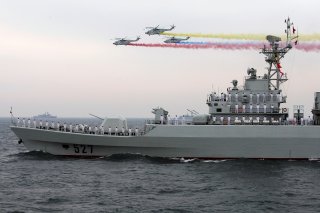Watch Out For China's Newest High-Tech Aircraft Carrier
Unlike the Ukrainian-built Liaoning, China’s first carrier, and its first domestically built carrier, the Shandong, the third Chinese carrier is not built with a ski-jump kind of aircraft take-off ramp.
Here’s What You Need to Remember: Nonetheless, apart from an electromagnetic catapult, it is not clear what, if any, additional U.S. Navy Ford-class technologies may have been replicated by China’s new carrier, apart from its external design.
China may likely launch its third aircraft carrier as soon as this year, bringing yet another dimension to its ability to project high-tech, forward operating maritime warfare power and introducing a series of new naval combat technologies somewhat analogous to the U.S. Navy’s Ford-class carriers.
The third Chinese carrier, which emerges as China’s second indigenously-built carrier, is described as being much larger and high-tech than previous ships and incorporating an electromagnetic catapult.
A report in the Chinese government-backed Global Times newspaper says the new carrier is likely to formally enter service by as soon as 2025.
Unlike the Ukrainian-built Liaoning, China’s first carrier, and its first domestically built carrier, the Shandong, the third Chinese carrier is not built with a ski-jump kind of aircraft take-off ramp. Rather, it looks more like a large, flat-decked U.S. carrier, and the use of an electromagnetic catapult is exactly the kind of technology now used by the U.S. Ford class.
The Global Times reports that the new carrier will be about 320 meters long, surpassing the Shandong's 305 meters, and be able to operate a carrier air wing of more than 40 fixed-wing fighters.
Electromagnetic catapult technology is intended to support a smoother kind of take-off and improve long-term aircraft maintenance by placing less stress on the jets as they take off. Unlike the so-described “shot-gun” type of steam catapult used on carriers in recent years, an electromagnetic catapult generates a more continuous, progressive thrust to propel the aircraft forward out over the ocean.
The existence of the Chinese electromagnetic catapult, a technology first developed and integrated by the U.S. Navy in recent years, certainly raises the question as to whether some of its innovations were stolen; there has been and continues to be longstanding, substantial concern that, through cyber-attack or other kinds of data theft, the Chinese military has been copying specs and technologies used by the U.S. military.
The use of this kind of catapult, which relies upon higher levels of generated electrical power, can enable more efficient usage of a carrier flight deck and expedite the refueling and take off process for attack missions. The thrust, or electrical force of the propulsion system can be tailored to the specific size and configuration of the aircraft it is launching, U.S. Navy Ford-class technology developers have explained to The National Interest.
The technical functionality of the electromagnetic catapult relies in large measure upon a much-increased ship capacity to generate electrical power. The USS Ford is able to generate 13,800 volts of electrical power, more than three times the 4,160 volts that a Nimitz-class carrier generates.
Nonetheless, apart from an electromagnetic catapult, it is not clear what, if any, additional U.S. Navy Ford-class technologies may have been replicated by China’s new carrier, apart from its external design. More space on the flight deck clearly increases a sortie rate by virtue of enabling larger numbers of aircraft to park, move and take-off.
The U.S. Ford-class also has electronic elevators for faster and more efficient refueling and rearming of attack aircraft, something which massively expedites the sortie rate for maritime combat operations. The Ford carriers also rely upon breakthrough levels of computer automation to increase technical efficiency, improve maintenance and reduce the needed crew size by nearly 1,000 sailors.
Kris Osborn is the defense editor for the National Interest. Osborn previously served at the Pentagon as a Highly Qualified Expert with the Office of the Assistant Secretary of the Army—Acquisition, Logistics & Technology. Osborn has also worked as an anchor and on-air military specialist at national TV networks. He has appeared as a guest military expert on Fox News, MSNBC, The Military Channel, and The History Channel. He also has a Masters Degree in Comparative Literature from Columbia University.
This piece first appeared earlier this year and is being reprinted due to reader interest.
Image: Reuters.

